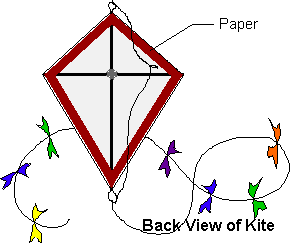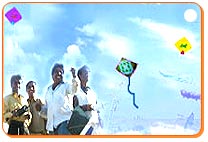Uttarayan
One of the most celebrated festivals of Gujarat. In the month of January, people in large numbers gather on terraces to fly kites of various colors to celebrate Uttrayana, the welcome to the sun after the cold winter months. The atmosphere at the festival is electrifying-glass strengthened threads of the Indian fighter kites are matched against each other in the air, and the kite fighter who cuts the other thread is the victor.
Lohri marks the end of a long winter with the return of the sun to the Northern Hemisphere and hence the name Uttarayan. It is celebrated all over Gujarat but the excitement runs highest at Ahmedabad, Surat (known particularly for the strong string which is made by applying glass powder on the row thread to provide it a cutting edge) Nadiad and Vadodara. To be in any one of these places during this festival is to feel the heart and pulse of Gujarat and its people.
The day of Uttarayan has special importance and is regarded as very auspicious. It is also believed that the Gods sleep for six months closing the doors of heaven, which open at the entrance of the sun in northern zone, i.e. in the orbit of Makara , when the Gods awake from a long slumber.
Uttarayan also has a significant relationship with the agricultural economy of the state. By this time, the Kharif crops are ready and are brought home. In an economy which is purely agricultural, domestic animals are not forgotten and grass is freely distributed to the village cattle. Uttarayan, thus, becomes a harvest festival in the true sense of the term.
In Gujarat grain from the new harvest is used to cook 'khichdo'. Typical food like Undiya, sugar cane juice and local sweets are served to celebrate the day. Cows and trees are also offered pujan since man's existence depends on them. People forget and forgive ill will. For this, they ritually offer each other food balls made of sesame seed and jaggery. This is common in Maharashtra too. In east India, at Gangasagar, thousands of pilgrims throng to Kapil Muni's ashram on this day for darshan.
A kite consists of these basic parts:
The Spine. The up-and-down, or vertical stick that you build your kite around.
The Spar. The support stick(s), that are placed crossways or at a slant over the spine. Sometimes they are curved or bowed.
The Frame. The joined spine and spars, usually with a string connecting their ends, that form the shape of the kite and make a support for the cover.
The Cover. The paper, plastic, or cloth, that cover the frame to make a kite.
The Bridle. One or more strings attached to the spine or spars, which help control the kite in the air.
The Flying Line. The string running from the kites’ bridle, where you hold to fly the kite.
The Tail. A long strip of paper or plastic of ribbon that helps to balance the kite in flight. Not all kites need tails.
The Reel. The object you use to wind your flying line, to keep it form getting tangled or flying away.

MAKE YOUR OWN DIAMOND KITE:
Materials:
- butcher cord or thin garden twine
- scotch tape or glue
- 1 sheet of strong paper (102cm x 102cm)
- 2 strong, straight wooden sticks of bamboo or wooden doweling 90cm and 102cm
- markers, paint or crayons to decorate you kite.

1. Make a cross with the two sticks, with the shorter stick placed horizontally across the longer stick. Make sure that both sides of the cross piece is equal in width.
2. Tie the two sticks together with the string in such a way as to make sure that they are at right angles to each other. A good way to ensure that the joint is strong to put a dab of glue to stick it in place.

3. Cut a notch at each end of both sticks. Make it deep enough for the type of string you are using to fit in to. Cut a piece of string long enough to stretch all around the kite frame. Make a loop in the top notch and fasten it by wrapping the string around the stick. Stretch the string through the notch at one end of the cross-piece, and make another loop at the bottom. Stretch the string through the notch at one end of the loop at the bottom. Stretch the string through the notch at the other end of the cross-piece. Finish by wrapping the string a few times around the top of the stick and cutting off what you don't need. This string frame must be taut, but not so tight as to warp the sticks.
4. Lay the sail material flat and place the stick frame face down on top. Cut around it, leaving about 2-3cm for a margin. Fold these edges over the string frame and tape or glue it down so that the material is tight.

5. Cut a piece of string about 122 cm long. and tie one end to the loop at the other end of the string to the loop at the bottom. Tie another small loop in the string just above the intersection of the two cross pieces. This will be the kite's bridle, the string to which the flying line is attached.
6. Make a tail by tying a small ribbon roughly every 10cm along the length of string. Attach the tail to the loop at the bottom of the kite.
7. Decorate!
Tips:
- A properly located pivot point is generally located slightly ahead of the centre of gravity.
- Cut away from you!
- Spray can glue is really good for patching up paper kites.
- Stability is improved by the use of an effective bow and a flexible tail.
- Hold your kite up by the string when you are finished to see if it is balanced. You can balance it by putting more paper on one side.
- Kites are different each time you make one, so slight adjustments might need to be made for each kite.




No comments:
Post a Comment